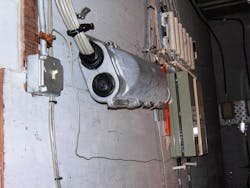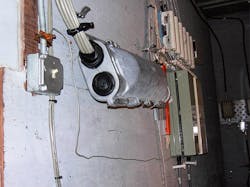What’s Wrong Here? Hint: Communications Breakdown
How well do you know the Code? Think you can spot violations the original installer either ignored or couldn't identify? Here's your chance to moonlight as an electrical inspector and second-guess someone else's work from the safety of your living room or office. It's your turn to identify the violation.
Hint: Communications breakdown
Find the Answer
Nice try by this installer, but I think they came up short when it comes to properly bonding and grounding this telephone communications system.
This building had no intersystem bonding termination point installed at the electrical service, as now required by Sec. 250.94. Even before this rule was added to the NEC, however, Sec. 800.100(B)(2) has several requirements when there is no intersystem bonding termination point. The requirements are as follows: The bonding or grounding electrode conductor for the communication system shall be connected to the nearest of the following accessible points:
1) the building’s grounding electrode system,
2) the first 5 ft of the grounded interior metal water pipe,
3) an external means at the power service enclosure,
4) a power service raceway,
5) the service equipment enclosure,
6) the power service grounding electrode or its enclosure, or
7) the power service grounding electrode conductor.
Nowhere does it permit the use of a branch circuit raceway to be used as the grounding and bonding point for the communication service.
Ironically, the power service was installed in the same room, but the installer took a shortcut and used the EMT for this light switch instead of going a little bit farther down the wall and connecting to the service raceways or service enclosures, as required.
About the Author

Russ LeBlanc
Owner
Russ started in the electrical trade as an apprentice in 1985. He worked his way up to become a Journeyman Electrician and then eventually became a Master Electrician and Licensed Construction Supervisor. In 1999 Russ become an Electrical Instructor for The Peterson School of Engineering in Massachusetts where he developed his passion for teaching, and quickly became Department Head of Electrical Instruction. Russ has taught thousands of apprentices, electricians, engineers, inspectors, and other electrical professionals during his career as an instructor. He continues to provide electrical professionals with Electrical Code seminars, Arc-Flash Awareness training seminars and educational material through his LeBlanc Consulting Services in North Reading, MA whose specialty is educating electricians. He has been an active member of the NFPA Electrical Section and has authored hundreds of National Electrical Code proposals and comments which have become Code rules to improve the safety for the electrical industry. Russ is also an IAEI certified Electrical Inspector.
Please visit www.russleblanc.net for more information.

